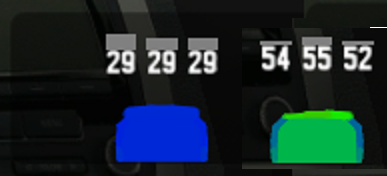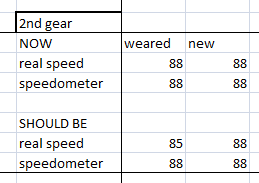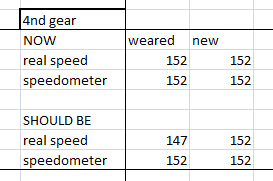In last few days I've done a lot of testing about tyres. (I have one question/suggestion)
Does LFS tyre model calculate that tyre wear changes diameter of wheel? If you ask me answer is NO.
Well someone will probably say that this changes are negligible, but actually they are not so small.
Different tyre diameter is like different gear ratio. Also pressure in tyre should change diameter, as well as temperature but that two are negligible compared to wear.
EXAMPLE:
Car used: XFG
XFG have 15 inch rims and 185/50 tyres = 56,6 cm diameter (got this values from LFS Tweak)
Picture weared / non-weared tyre:

Tyre height in our case is 185*0,5 = 92,5mm = 9,25cm (non-weared).
When you compare weared vs. non-weared tyre you can see clearly that weared tyre is at least 1 cm thicker. (which in normal for everyday car after few months of usage)
Our new real diameter is 54,6 cm of even lower.
If we compare these two values in percentage:
54,6/56,6 = 96,47%
That means car with weared tyres will travel 3,5% less distance compared to car with non-weared tyres if their wheels have same rotational speed.
Percentage varies a lot by wheel height. (smaller wheel = bigger difference)
If you compare car speeds at same rpm :
In table there are shown values for XFG (default set - HARD TRACK) at rev limiter (8000 rpm).
Weared speed value is calculated if tyre wear was 1 cm.
Real speed is measured using Aonio.
2nd gear

4th gear

I would like to hear developers opinion about that.
We want LFS as realistic as possible, right? Then this is must do thing. I hope this will be introduced with new tyre physics.
Does LFS tyre model calculate that tyre wear changes diameter of wheel? If you ask me answer is NO.
Well someone will probably say that this changes are negligible, but actually they are not so small.
Different tyre diameter is like different gear ratio. Also pressure in tyre should change diameter, as well as temperature but that two are negligible compared to wear.
EXAMPLE:
Car used: XFG
XFG have 15 inch rims and 185/50 tyres = 56,6 cm diameter (got this values from LFS Tweak)
Picture weared / non-weared tyre:
Tyre height in our case is 185*0,5 = 92,5mm = 9,25cm (non-weared).
When you compare weared vs. non-weared tyre you can see clearly that weared tyre is at least 1 cm thicker. (which in normal for everyday car after few months of usage)
Our new real diameter is 54,6 cm of even lower.
If we compare these two values in percentage:
54,6/56,6 = 96,47%
That means car with weared tyres will travel 3,5% less distance compared to car with non-weared tyres if their wheels have same rotational speed.
Percentage varies a lot by wheel height. (smaller wheel = bigger difference)
If you compare car speeds at same rpm :
In table there are shown values for XFG (default set - HARD TRACK) at rev limiter (8000 rpm).
Weared speed value is calculated if tyre wear was 1 cm.
Real speed is measured using Aonio.
2nd gear
4th gear
I would like to hear developers opinion about that.
We want LFS as realistic as possible, right? Then this is must do thing. I hope this will be introduced with new tyre physics.

 , I hope he finished his birthday party
, I hope he finished his birthday party 

 not to talk that most WRs times are lowered by 0.2 s with new tyre heaters
not to talk that most WRs times are lowered by 0.2 s with new tyre heaters